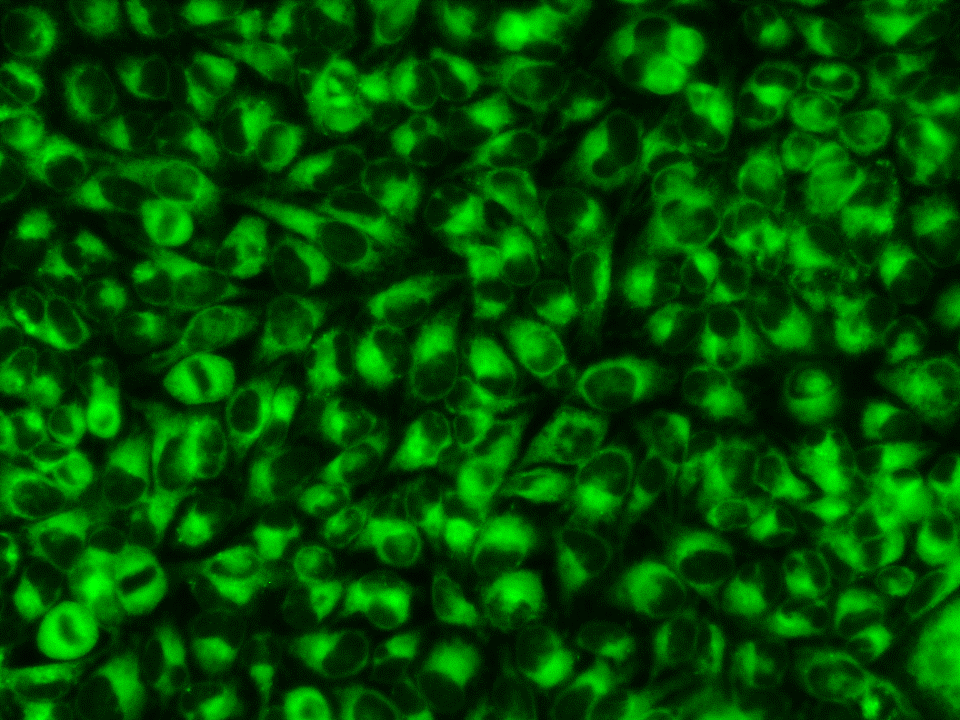Near-infrared fluorescent probe for high-sensitivity imaging
Sciforiem ™ FI Series
A near-infrared fluorescent probe for high-sensitivity imaging that enables observation of minute areas and long periods of time in regenerative medicine technology and cancer research.
Development product overview
With the development of regenerative medicine technology in recent years, cell observation technology has expanded to include high-sensitivity imaging to observe finer areas, long-term observation of dynamics, and in-vivo cell observation using near-infrared light, which has high bio-penetration. - Many new observation systems, such as protein dynamics observation, are being researched.
The colorants used in these new observation systems not only have optical properties such as light absorption and fluorescence emission, but also have clearer labels, long-term luminescence, and in-vivo properties that were not found in conventional biolabeling colorants. New features such as stability and resistance to high-power lasers are required.
This developed product has high fluorescence intensity, uniform cytoplasmic labeling, and excellent photostability, and is suitable for high-content analysis used in drug discovery screening and long-term observation with super-resolution microscopy using high-power lasers. , enables finer observation of biological tissues such as cells.


Appearance of developed fluorescent color material

Features of the developed product
Feature 1: High fluorescence intensity (observation using a fluorescence microscope *1*2)
Due to its high fluorescence intensity, advanced imaging is possible with a small amount of additives.

Existing product A

Development product
Feature 2 Homogeneous labeling of cells (observation using a fluorescence microscope *1 *2)
Individual cells can be labeled quickly and uniformly.

Existing product A

Development product
*1 When HeLa cells are labeled using near-infrared fluorescent dye
*2 Light in the near-infrared region cannot be recognized by the human eye, so it is visualized in green.
Feature 3: High photostability

It also has excellent durability, allowing long-term fluorescence observation.
Application example
Application example 1 Cell labeling (multiple labeling)
More advanced multiplexed labeling is possible because it uses fluorescence in the near-infrared region, which has a different wavelength from the visible light fluorescent colorant.
HeLa cells are stained and observed with a fluorescence microscope

* The colors in the images are visually displayed in green, blue, and red, respectively, for convenience according to the fluorescence wavelength emitted by each colorant.
Application example 2 Deep imaging
It exhibits high fluorescence intensity in the wavelength range that is highly permeable to living organisms, making it possible to image deep parts of living organisms. Additionally, by taking advantage of this feature, it is possible to observe minute areas such as capillaries, lymph vessels, and cancer tumor sites.
In vivo near-infrared biofluorescence imaging (intravenous inoculation, Ex720nm, Em795nm) *3

*3 Ex represents excitation wavelength and Em represents fluorescence detection wavelength.
Application example 3 Exosome imaging
Because it labels exosomes without aggregating them, accurate observation of exosome dynamics is possible.
Exosomes were introduced into all cells, indicating that exosomes labeled with this developed product have excellent cellular uptake.
Introducing stained exosomes into HeLa cells and observing them using a super-resolution confocal laser microscope (in collaboration with Nikon Co., Ltd.)

Magnification 60x
Existing product B

Magnification 60x
Development product

Magnification 210x
Existing product B

Magnification 210x
Development product
Green (exosome): Existing product B (Ex:561nm, Em582-618nm) *3
Blue (nucleus): Hoechst33258 (Ex:405nm,Em430-463nm nm) *3
*3 Ex represents excitation wavelength and Em represents fluorescence detection wavelength.
Application example 4 Others
It can be applied to gene amplification fluorescent labels, cell surface analysis fluorescent labels, identification of differentially expressed proteins, quantitative markers, immunohistological staining markers for pathological examinations, and fluorescent microparticles for in vitro diagnostics.
Technology overview
Colorant absorption/fluorescence wavelength control technology x Cell-interacting functional group introduction technology
The main light-absorbing substances that exist in living organisms are water (more than 2000 nm) and hemoglobin in blood (less than 700 nm), so light in the near-infrared region with a wavelength of 700 nm to 2000 nm is not absorbed by these substances. , penetrate deeply into living tissues. At our company, we have combined the "colorant absorption/fluorescence wavelength control technology" cultivated in the display and electronics fields with our unique "cell-interacting functional group introduction technology" to achieve clearer labeling functions, long-term luminescence maintenance, and We are developing colorants with characteristics suitable for new observation systems, such as in-vivo stability and photostability.
We aim to apply this coloring material not only to regenerative medicine but also to a wide range of fields such as biopharmaceutical screening and in vitro diagnostic systems.
Near-infrared region with high biological permeability

Colorant absorption/fluorescence wavelength control technology

Technology for introducing cell-interacting functional groups

Inquiries
artience Co., Ltd. Incubation Center
TEL: +81-3-3272-0242
